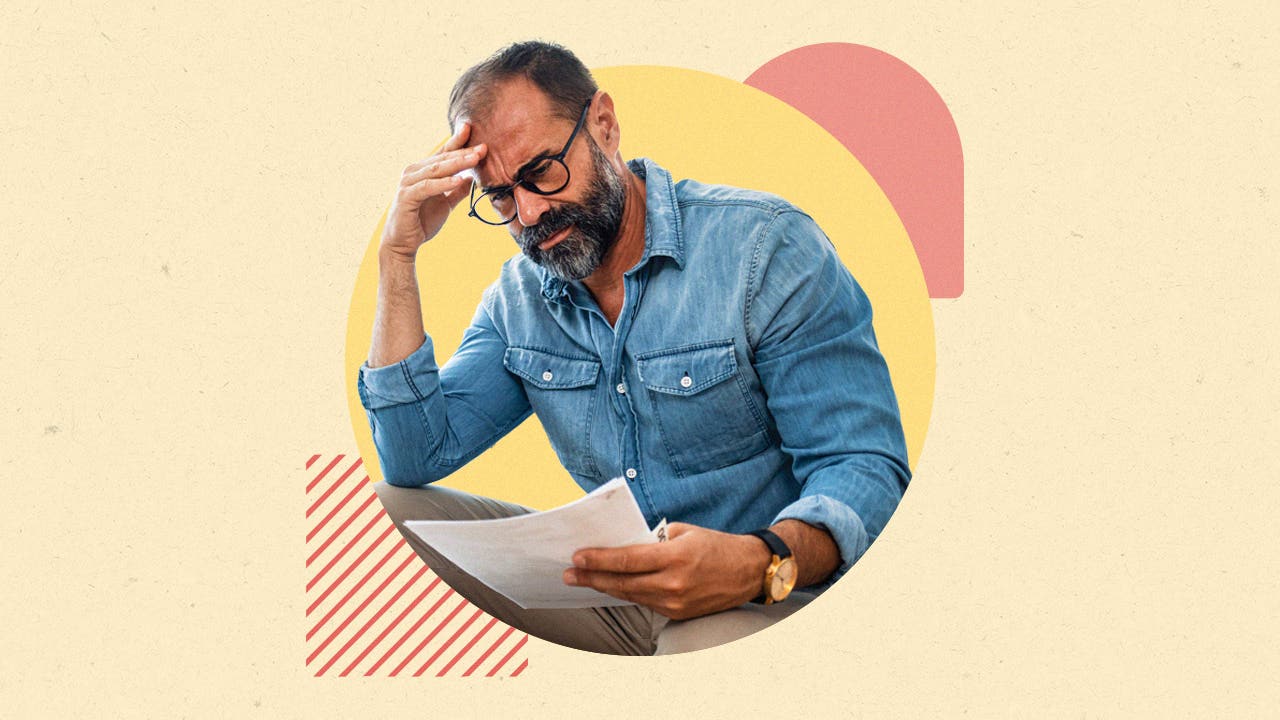What to do if you are denied a loan: Reasons for denials & ways to improve

The Bankrate promise
At Bankrate we strive to help you make smarter financial decisions. While we adhere to strict , this post may contain references to products from our partners. Here's an explanation for .
Key takeaways
- Lenders tend to tighten credit requirements during tough economic times, making it harder to get approved for credit products, including loans.
- Credit score, income and debt-to-income ratio are the main factors lenders consider when reviewing applications.
- Paying down debts, increasing your income, applying with a co-signer or co-borrower and looking for lenders that specialize in loans within your credit band could increase your approval odds.
If you recently applied for a personal loan and got denied you’re not alone. Bankrate’s credit denials survey found that half of Americans who’ve applied for a loan or another financial product since the Fed hiked its benchmark rate in March 2022, have gotten denied.
This is likely in part due to the fact that lenders tend to tighten their credit requirements during tough economic times to mitigate risks, which in turn makes it harder to get approved for a loan. Luckily, there are a few steps you can take to improve your approval odds, even in a tough economy.
- 50% of Americans who have applied for credit products since the Fed rate hikes in March 2022 have gotten denied, according to Bankrate’s Credit Denials survey.
- 17% were denied more than one loan or financial product.
- 21% of Americans say it has gotten harder to access credit since the Fed increased interest rates, with 11% saying it has gotten much harder.
- New credit card applications, including balance transfer cards, accounted for the majority of credit denials at 19%.
- Credit card limit increase denials (at 11%) came in second, followed by personal loans (at 10%).
Why it’s been harder to get approved for a loan
Borrowers with good to excellent credit are still most likely to get approved for a loan, although the APRs (annual percentage rates) offered are likely to be much higher than they would have been last year.
The cost of borrowing has greatly increased as lenders adjust to the Federal Reserve raising the benchmark rate. What’s more, lenders have also become more selective about who qualifies for approval as the inflation rate remains stubbornly high, despite the Fed’s recent behaviors.
Reasons for personal loan rejections
There are several reasons someone may have their loan application rejected:
- Bad credit history: Bad credit history may indicate to creditors that you are having or had trouble repaying what you owe based on past transactions. Although your credit score is generally a good indicator of credit history, lenders also look at your overall financial history to establish your creditworthiness.
- High DTI: If you have a DTI — or debt-to-income — ratio of 50 percent or higher, you might have too much debt for a lender to give you a new loan. If that’s the case, it’s best to apply after reducing your overall debt, as this will increase your chances of approval.
- Incomplete application: Your loan rejection could be as simple as missing a key field or document needed for verification. If you are rejected for a loan, double-check that you fully completed the application and submitted all the proper documentation.
- Lack of proof of steady income: Consistency is key because it helps lenders understand your job landscape moving forward. Because jobs can vary depending on the line of work, lenders may look at tax returns to get a better overview.
- Loan doesn’t fit the purpose: Lenders might have certain restrictions on what you can and can’t do with loan money. The lender may be able to offer you alternative suggestions to better fit your needs.
- Unsteady employment history: Lenders like to see a steady income stream over time. If you are between jobs or have a history of unsteady employment, this could indicate to lenders that you may not be a reliable borrower.
How to improve your chances of qualifying for a loan
There are a few measures you can take to improve your approval odds when applying for a personal loan. But for any of these steps to work you must know why you got denied in the first place.
Under the Equal Credit Opportunity Act, lenders must disclose the reason for denying your loan application as long as you inquire about it within 60 days of the decision. This is known as an adverse action notice. Knowing this information is key to developing an effective strategy to get approved next time.
-
Your credit score is the single most important factor when qualifying for a loan. It also goes into determining how much you’ll pay in interest. As a rule, the higher your credit score is, the more likely you are to receive favorable APRs and low fees.
If you aren’t sure whether your credit score is in mint condition, the best thing you can do is review a copy of your credit report. You can request a free copy of your report from all three bureaus every week by visiting AnnualCreditReport.com. Although this won’t show you your actual score, it will give you an idea of where you stand with creditors, as well as if there are mistakes that need to be corrected.
Aside from that, make all debt payments on time and keep your credit card balances low to avoid piling on extra debt. Both are simple ways to nurse your credit back to a healthy state. You can also become an authorized user on someone else’s account. However, this will only boost your score if the person has a good payment history and a low credit utilization rate. -
Lenders typically look for a DTI under 36 percent, although some allow applicants with DTIs as high as 50 percent. If a high debt-to-income ratio affects your ability to take out a loan, work on paying down your current debts before applying for more credit.
One way to do that is to tighten your budget and cut down on monthly credit card expenses. If you have different types of debt (credit cards, loans, etc.) you can try using the snowball or the avalanche payoff strategy.
The snowball strategy consists of paying off your smallest debt — regardless of the interest rate — and moving up from there. The avalanche method focuses on paying off the account with the highest interest first — regardless of the balance — and working down from there. -
A higher income can help lower your DTI and make you more attractive to lenders. Finding ways to supplement your income could improve your chances of qualifying for a loan. Consider asking for a raise at your current job, especially if you haven’t received one in a while.
Another option is to take on a side gig. Bankrate’s side hustle survey found that 39 percent of U.S. adults have a side hustle, out of which, 33 percent use it to pay for regular living expenses. Some viable options that don’t require a lot of time commitment if you already have a full-time job include tutoring, dog walking and online sales. -
Various lenders have different requirements, rates, terms and fees. Research lenders and compare rates before applying to one. The lender that will work best for you depends on your specific financial situation and needs.
Prequalifying with a few lenders is a good idea to see exactly what you will be eligible for before fully applying. You can get a personal loan from online lenders, banks and credit unions. Each option caters to people with different incomes, credit scores and personal life schedules. -
Although prequalifying is not guaranteed approval, getting a prequalified offer means you met the initial requirements. Many lenders allow you to prequalify without affecting your credit score or making a commitment. However, your application could be denied if something changes, such as your income or credit score.
When you are ready to fully apply, ensure that your documentation is up to date to reflect all the hard work and changes you made. If you are still unsure if you will qualify, try finding a co-signer.
When to apply for a loan again after denial
Each time you apply for a loan or credit product there is a hard inquiry that can temporarily lower your score. That’s why it’s a good idea to wait at least 30 days before you apply again. However, if you don’t need the funds urgently, experts recommend waiting at least six months.
How to get a loan with bad credit
There are a few ways you could still get approved for a personal loan, even with less-than-perfect credit.
Add a co-borrower or co-signer
Co-borrowers and co-signers are typically creditworthy family members or friends who sign the loan agreement with the primary applicant and take on equal legal responsibility for the loan. This, in turn, can boost the chances of approval of the primary applicant, plus help them secure a better rate.
The main difference between the two is that the co-borrower has access to the loan funds, while the co-signer doesn’t. Both co-borrowers and co-signers are equally responsible for payments, but co-signers typically only make payments if the borrower is at risk of defaulting on the loan.
Consider the potential relational risks before enlisting the assistance of a co-borrower or co-signer. Also make sure the monthly payment is well within your budget, both now and in the future, to avoid negatively impacting their credit as well as yours.
Consider getting a secured loan
Secured loans are those that are backed by an asset, such as a car or a savings account. Though not many, some personal loan lenders do offer these products. If you have enough equity built in your home, you may also be able to apply for a home equity loan or a home equity line of credit (HELOC). Both are second mortgages backed by your home.
Because secured loans are guaranteed by an asset, lenders tend to be more lenient with credit requirements and offer lower rates. That said, if you default on the loan, the lender could take legal action to seize the asset. Additionally, home equity loans and HELOCs usually entail a lengthy approval process and are best suited if you need a considerable amount. Otherwise, they may not be worth the trouble or risk.
Target your search toward lenders within your credit band
If you need money quickly there are loans for bad credit borrowers that tend to have more relaxed requirements. However, be aware that your interest rates may potentially be higher than if you qualified for a good credit loan. Regardless, if you can handle the higher payments and interest, without tilting your budget, it may be a good option to explore.
The bottom line
If you have been denied a loan, take the time to review your application and see what went wrong. Then, work on improving the aspects that got you denied in the first place. For instance, if the main issue is that your DTI is too high, consider paying down debt before reapplying.
But if you’re in a crunch, there are lenders that offer loans to those with bad credit. But be sure to carefully consider the interest rates and your ability to make payments before you apply. It’s also important to wait at least one month before reapplying after getting denied and to only borrow an amount that you can comfortably repay.

